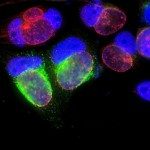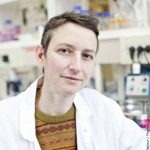Link to Pubmed [PMID] – 24465954
PLoS ONE 2014;9(1):e86196
Chlamydia trachomatis is an obligate intracellular pathogen responsible for loss of eyesight through trachoma and for millions of cases annually of sexually transmitted diseases. The bacteria develop within a membrane-bounded inclusion. They lack enzymes for several biosynthetic pathways, including those to make some phospholipids, and exploit their host to compensate. Three-dimensional fluorescence microscopy demonstrates that small organelles of the host, peroxisomes, are translocated into the Chlamydia inclusion and are found adjacent to the bacteria. In cells deficient for peroxisome biogenesis the bacteria are able to multiply and give rise to infectious progeny, demonstrating that peroxisomes are not essential for bacterial development in vitro. Mass spectrometry-based lipidomics reveal the presence in C. trachomatis of plasmalogens, ether phospholipids whose synthesis begins in peroxisomes and have never been described in aerobic bacteria before. Some of the bacterial plasmalogens are novel structures containing bacteria-specific odd-chain fatty acids; they are not made in uninfected cells nor in peroxisome-deficient cells. Their biosynthesis is thus accomplished by the metabolic collaboration of peroxisomes and bacteria.



